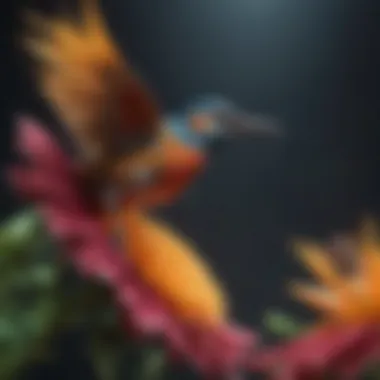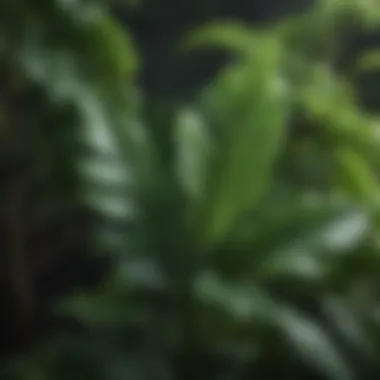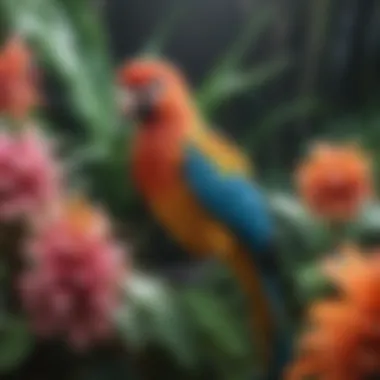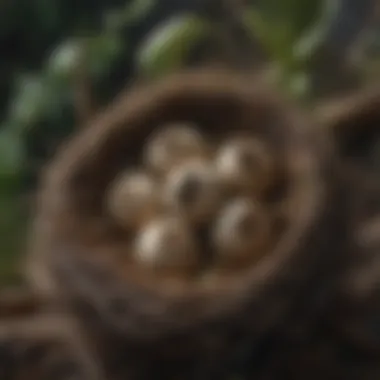Discovering Plants That Mimic Birds: A Botanical Journey


Intro
Plants that mimic the appearance of birds create a fascinating intersection between botany and ornithology. Their unique structures are not just visually appealing; they serve distinct ecological roles within their environments. These avian-like plants embody adaptability and resilience, thriving in various ecological niches. This exploration offers insight into their cultural significance, raising questions about evolutionary mechanics and biodiversity.
Fascinating Facts About the Plant
Unique Characteristics
Some plants exhibit features that closely resemble birds. For example, the Impatiens omeiana, commonly known as the Chinese touch-me-not, has blooms that resemble the soft plumage of certain songbirds. Their petals may have colors and patterns that mimic the brightness found in avian species. The adaptability of these plants allows them to thrive in various environments, much like birds that have evolved different traits to suit their specific habitats.
Extraordinary Abilities
These avian-like plants often display unique reproductive strategies that enhance their survival. Certain species utilize bird-attracting traits, like brightly colored flowers or seed shapes that resemble bird nests. This clever mimicry ensures that birds help with pollination and seed dispersal, further integrating the relationship between flora and fauna.
Behavior and Habitat
Natural Habitats
Avian-like plants can be found in diverse habitats, ranging from tropical rainforests to arid deserts. Each species has adapted to specific environmental conditions, illustrating their resilience. For instance, the Cyclamen hederifolium thrives in shady woodlands, while the striking Anthurium flowers succeed in moist tropical areas, capitalizing on the interplay of light and moisture.
Social Structures
While most plants do not display social structures in the same way as animals do, some species create symbiotic relationships with neighboring flora and fauna. For example, many avian-like plants rely on birds for seed dispersal, forming an invisible network of cooperation that contributes to the health and diversity of ecosystems. Their coexistence shows us the balance of life within natural environments.
Recent Scientific Discoveries
Latest Research Findings
Research has advanced in understanding the structural adaptations of these plants. Studies indicate that certain species have evolved volatile compounds that attract specific bird species for pollination. This ongoing research links flowering time to bird migration patterns, showcasing a dynamic interdependence.
Breakthroughs in Plant Biology
Breakthroughs in plant biology relate to genetic modifications that enhance traits similar to birds. Scientists explore how these adaptations may influence ecosystem resilience in changing climates. Understanding these connections gives insight into both plant survival mechanisms and broader ecological impacts.
Cultural Significance
Plants in Folklore
In various cultures, plants resembling birds have captured human imagination. They feature in folklore, symbolizing freedom or transformation. For example, the Hibiscus flower is often associated with beauty and art surrounding avian life in different myths and legends.
Influence on Art and Literature
Artists and writers have drawn inspiration from the beauty of avian-like plants. These forms often appear in paintings and literature, serving to bridge the gap between the natural world and human creativity. The symbolic representation of such plants reveals how closely linked nature and culture are.
These unique plants remind us of the intricate connections within ecosystems, inspiring a deeper appreciation for nature.
Prelude
The exploration of plants that resemble birds invites an intriguing intersection between botany and ornithology. Plants with such unique structures hold more significance than their aesthetic appeal; they embody intricate adaptations that allow them to thrive in diverse ecosystems. Understanding these plants can enrich knowledge in ecological roles, biodiversity, and cultural significance. Their striking forms not only catch the eye but also reveal insights into evolutionary processes.
As we delve into this subject, we will uncover how certain species exhibit avian-like characteristics. This exploration extends beyond visual similarities, shedding light on factors such as
- Pollinator interactions
- Ecosystem contributions
- Cultural symbols
This article, aimed at veterinarians, wildlife biologists, and families, seeks to provide a comprehensive understanding of these fascinating plants while emphasizing the importance of biodiversity.
Understanding the Connection Between Plants and Birds


The relationship between plants and birds is profound and multifaceted. Birds play a crucial role in the pollination and seed dispersal of many flowering plants. In return, plants often adapt their structures and colors to attract specific bird species. This dynamic is not just limited to obvious interactions; it is often based on co-evolution.
The physical characteristics of certain plants can sometimes mimic birds, both in form and function. This mimicry can serve several purposes:
- Attraction of pollinators: Many bird-like plants have features that attract bird pollinators, increasing reproductive success.
- Camouflage and protection: The unique shapes may help in evading herbivores or managing sunlight exposure.
- Cultural representation: In various cultures, these plants are often celebrated for their beauty and significance.
By understanding the connections between plants and birds, we gain insight into their broader ecological networks and appreciate the complexity of evolutionary adaptations.
Defining Bird-Resembling Plants
Understanding what constitutes a bird-resembling plant is crucial for appreciating their unique characteristics and contributions to the environment. By defining these plants, we delve into the intricate relationship between botany and ornithology. The appeal of these plants lies not only in their aesthetics but also in their ecological roles and how they have adapted features reminiscent of birds.
Bird-like plants often showcase distinctive structures that serve specific functions. Recognizing these features enables us to comprehend the evolutionary advantages these plants possess. Additionally, defining them helps raise awareness about biodiversity and the importance of conserving such unique species.
Unique Structural Features
Bird-resembling plants exhibit characteristics that often mimic certain aspects of birds, such as their coloration and form. These structural features can be categorized as follows:
- Shape and Form: Many species possess floral structures that appear like bird wings or feathers. This adaptation can attract pollinators that are crucial for the plants' reproduction.
- Coloration: Bright, vibrant colors mimic the plumage of birds. These hues signify health and vitality, attracting both pollinators and cultivators alike.
- Growth Patterns: Some bird-like plants develop in ways that optimize their exposure to sunlight and rain. Their arrangement can resemble the open wings of a bird, which increases their chances of survival in competing environments.
Key Examples of Bird-Like Plants
Understanding the examples of bird-like plants is vital in our study. Each species exhibits unique forms and adaptations that not only charm the observer but also play significant roles in their respective ecosystems. These examples provide insights into biodiversity and the intricate relationships between plants and their surroundings. They highlight the importance of recognizing the benefits that these plants offer in terms of aesthetic value, ecological contribution, and cultural impacts.
The Parrot Plant (Heliconia)
The Parrot Plant, belonging to the Heliconia genus, is notable for its vibrant inflorescences. These plants thrive in tropical regions and are engineered for survival. Their structures mimic the beak of a parrot, which contributes to their name. This resemblance is not merely coincidental; it is an evolutionary tactic. Hummingbirds, which are the primary pollinators, are attracted to these bright blossoms, fostering a mutualistic relationship. These plants can grow as tall as 15 feet, displaying unique colors ranging from red to yellow to orange. Their leaves are also large and often resemble the elongated wings of birds, further enhancing their aesthetic appeal. Keeping them healthy requires warm, humid environments with well-drained soil and plenty of nutrients. The Parrot Plant’s role in the ecological community emphasizes its vital input in supporting biodiversity through pollination.
The Bird of Paradise (Strelitzia reginae)
The Bird of Paradise, scientifically known as Strelitzia reginae, is another exemplary plant that resembles avian features. This plant is native to South Africa and is famed for its spectacular flowers that emulate the head and plumage of a bird in flight. These flowers possess an intricate structure that attracts pollinators, particularly sunbirds, which are akin to hummingbirds. The Bird of Paradise thrives in well-draining soil and requires ample sunlight to flourish. Its lush green leaves can grow up to two feet long, providing an impressive background for the stunning flowers. Gardeners appreciate this plant for its striking appearance, making it a popular choice for ornamental use. The significance of Strelitzia reginae lies in its ability to draw attention to the importance of conservation in its native habitat, as it faces threats from habitat loss.
The Ibis Plant (Ravenala madagascariensis)
Known as the Ibis Plant, Ravenala madagascariensis captures the essence of its namesake bird through its fan-like structure. Native to Madagascar, this plant thrives in tropical climates and can reach heights of up to 30 feet. The leaves are long and paddle-shaped, resembling the wings of an ibis. The plant is distinguishable for its unique growth pattern, where leaves grow in a distinct fan formation, creating a stunning visual impact. It also plays a crucial role in its ecosystem, providing shelter and food for various species. Moreover, the Ibis Plant’s iconic appearance makes it a favorite for landscape design. Understanding the ecological and cultural significance of Ravenala madagascariensis enhances our appreciation for biodiversity and the need for preservation efforts.
Bird-like plants not only enhance the beauty of their surroundings but also serve critical ecological functions.
The exploration of these examples of bird-like plants enriches our understanding of biodiversity while showcasing the remarkable adaptability of flora in diverse habitats. Engaging with these species fosters deeper appreciation and encourages conservation, ensuring that future generations can continue to enjoy their beauty and benefits.
Ecological Roles of Bird-Like Plants
Bird-like plants serve crucial functions in their ecosystems. Their unique structures do not just mimic birds aesthetically; they hold ecological significance that supports various species and contributes to biodiversity. Understanding these roles allows us to appreciate their value beyond ornamental appearances.
Importance in Ecosystems
Bird-like plants, such as the Bird of Paradise and the Ibis plant, thrive in specific habitats, providing essential resources. They create microhabitats that offer shelter and food**.** This is important for both flora and fauna.
- Habitat Structuring: These plants provide critical cover and nesting sites for various bird species. Species like hummingbirds and sunbirds often rely on such plants for breeding.
- Biodiversity Support: By supporting a variety of insects and small animals, bird-like plants promote greater biodiversity within ecosystems. This variety can improve the resilience of ecosystems to changes, such as climate variations.
- Soil Stabilization: Many of these plants have root systems that help prevent soil erosion. This is particularly important in areas susceptible to degradation, contributing to soil health.
In summary, the importance of bird-like plants in ecosystems cannot be understated. They serve as life-supporting agents within their environments.
Attracting Pollinators
Bird-like plants are also known for their ability to attract pollinators. This quality is crucial for plant reproduction and has broader implications for ecological balance. The specialized structures of plants like the Parrot Plant are evolutionarily adapted to entice specific pollinators.
- Nectar Production: Many bird-like plants produce vibrant flowers that are rich in nectar. This attracts bees, butterflies, and birds, which play an essential role in pollination.
- Color and Shape: The unique coloration and shapes of these flowers are designed to catch the eye of potential pollinators. Birds, particularly, are drawn to bright hues; thus, these plants enhance pollination efficiency.


Pollinators are essential for food production, and bird-like plants help sustain these vital species.
- Mutual Relationships: The relationship between bird-like plants and pollinators is often mutualistic. Pollinators gain nourishment while enabling plants to reproduce. This interdependence reinforces the health of the ecosystem overall.
Cultural Significance of Bird-Like Plants
The cultural significance of bird-like plants transcends mere aesthetic appeal. These plants often symbolize deeper connections between nature and humanity, manifesting in various traditions and beliefs across different cultures. Their unique forms and colors capture the imagination, prompting various interpretations and uses.
Symbolism in Various Cultures
In numerous cultures, bird-like plants serve as powerful symbols. For instance, the Bird of Paradise flower is deeply associated with beauty and freedom in Hawaiian culture. This flower is often used in leis and celebrations, signifying joy and a connection to nature. Similarly, the Heliconia, or parrot plant, holds significance in Caribbean folklore, representing strength and resilience, reflecting the vibrant life found in lush tropical ecosystems.
Moreover, the symbolism varies depending on the region. In some Southeast Asian cultures, these plants are seen as indicators of good fortune. Their bright colors and striking shapes are thought to bring happiness and prosperity. This cultural context enriches the appreciation of these plants, as they embody values significant to specific communities.
Uses in Art and Decoration
Bird-like plants have inspired countless artistic expressions. Their striking appearance often finds its way into various art forms, from paintings to textiles. Artists frequently incorporate the vivid colors and unique shapes of these plants into their work, creating pieces that reflect the beauty of nature.
In decor, these plants play a crucial role as well. Many interior designers emphasize bird-like plants like the Bird of Paradise or the Ibis Plant to add a touch of exoticism and vibrancy to spaces. Their ability to thrive in indoor environments allows homeowners to bring a piece of nature indoors, enhancing aesthetic appeal and evoking a sense of tranquility.
Key Considerations:
- Cultural Representation: Understanding the symbolism helps appreciate the historical context.
- Artistic Influence: Their unique forms serve as muse for creativity in various media.
- Interior Design: Practical use in homes enhances both beauty and mood.
Bird-like plants are not only botanical wonders but also serve as vessels of cultural narratives, connecting people to their heritage and environment.
In summary, the cultural significance of bird-like plants extends beyond their appearance. They symbolize values and beliefs while simultaneously inspiring artistic endeavors. Through their use in celebrations and decor, these plants remain a vital thread in the tapestry of human expression and connection to the natural world.
Growth Conditions and Care
The growth conditions and care for bird-like plants are critical for their health and vitality. These plants often require specific environments that mimic their native habitats. Understanding these needs can profoundly affect their growth and flowering. Given their uniqueness, meeting their conditions is imperative for ensuring their aesthetic and ecological benefits.
Optimal Environments
Bird-like plants thrive in optimal environments that cater to their specific needs. Many of these plants originate from tropical and subtropical regions, where the climate is warm and humid. For instance, the Bird of Paradise flourishes in temperatures ranging from 65 to 70°F (18 to 21°C) at night and up to 70 to 90°F (21 to 32°C) during the day.
- Light Requirements: Most avian-like species prefer bright, indirect sunlight. Direct sunlight can scorch their leaves, while too little light may inhibit their ability to flower. Consider a location where they can receive filtered light.
- Soil Composition: Well-draining soil is necessary. A mix of potting soil, sand, and perlite typically works well for these plants, allowing air to circulate around the roots.
- Humidity Levels: High humidity is beneficial. If you live in a dry area, consider using a humidifier or placing the plant on a tray filled with water and pebbles to increase moisture in the air.
Common Planting Techniques
Effective planting techniques can ensure that these remarkable plants thrive. Here are several key considerations:
- Planting Depth: When repotting, ensure that the plant is positioned at the same depth it was previously growing. This helps to prevent stress and promotes healthy root development.
- Watering Schedule: Proper watering is crucial. These plants prefer their soil to dry out a bit between waterings. Water them thoroughly and let excess drain away.
- Fertilization: Fertilizing during the growing season can greatly enhance growth. A balanced, slow-release fertilizer every few months can provide necessary nutrients without overwhelming the plant.
In summary, understanding optimal environments and common planting techniques are vital to successfully caring for bird-like plants. Their unique characteristics necessitate specific conditions that promote health and growth, thus providing both beauty and ecological benefits.
Economic Aspects of Bird-Like Plants
Bird-like plants hold significant economic value, both commercially and within local communities. The growing interest in horticulture and eco-tourism has pushed these unique plants into the spotlight. They are not only visually appealing but also serve various functions in trade and local economies. The economic aspects involve understanding how these plants affect markets, communities, and the environment.
Commercial Uses and Trade
Bird-like plants such as the Bird of Paradise (Strelitzia reginae) and the Parrot Plant (Heliconia) are sought after in the floral industry. Their exotic appearance makes them favorites for landscaping, weddings, and other celebratory events. The growing demand for these plants has led to an increase in cultivation as nurseries and growers specialize in breeding new varieties.
- Landscaping: Their striking flowers and leaves add aesthetic value to gardens and urban settings, driving landscape architecture trends.
- Cut Flowers: As cut flowers, they are prized for their longevity and unique forms, making them popular in arrangements.
- Exports: Countries rich in biodiversity, such as Madagascar and tropical regions, export these plants, contributing to international trade.


In addition to floriculture, many bird-like plants serve practical purposes, such as medicinal uses or even food sources in certain cultures. These factors contribute to their economic significance, encouraging sustainable harvesting and cultivation practices.
Impacts on Local Economies
The cultivation and trade of bird-like plants have notable impacts on local economies, particularly in regions where these plants are native. They create job opportunities and support livelihoods.
- Job Creation: Local farmers often rely on the demand for these plants. They can participate in growing and selling these products, generating income.
- Sustainable Practices: As awareness of biodiversity and ecological sustainability grows, there is a trend towards cultivating these plants in a manner that conserves their natural populations. This encourages eco-friendly practices.
- Tourism: Ecotourism has taken off around locations rich in these plants. Tours featuring botanical gardens or unique flora can attract visitors, further bolstering local economies.
Conservation Challenges
The Importance of Conservation Challenges in Bird-Like Plants
Conservation challenges related to bird-like plants are crucial for understanding the broader implications of biodiversity. As these unique plants often serve as key components in their ecosystems, their survival affects numerous species, including various avian populations. Preserving these plant species is not only vital for maintaining ecological balance but also for sustaining the myriad interactions that occur between flora and fauna.
The decline or extinction of a bird-like plant can lead to losses in habitat for pollinators and other wildlife. This interconnectedness emphasizes the need for targeted conservation efforts that prioritize the protection of these specific plants. Addressing conservation challenges can lead to enhanced ecological health and resilience, which is beneficial for both human societies and natural ecosystems.
Threats to Bird-Like Plants
The threats to bird-like plants are numerous and varied. Habitat loss stands out as the most significant, often driven by urbanization, agriculture, and deforestation. When areas that support these species are converted for other uses, the unique ecosystems that sustain them are disrupted. Additionally, climate change poses a considerable risk, affecting temperature and precipitation patterns. These changes can hinder the growth and reproduction of plants that have specialized climate needs.
Pollution also plays a role, as chemicals can have detrimental effects on plant health. Invasive species often outcompete native bird-like plants, leading to their decline. The combination of these factors creates a precarious situation for species that rely on specific ecological conditions.
Conservation Efforts and Strategies
Several conservation efforts can be employed to address these challenges. A key strategy involves habitat restoration, which aims to rehabilitate and reestablish environments where bird-like plants can thrive. Reforestation and wetland restoration projects can play a significant role in expanding the habitat for these species.
Captive breeding programs are also essential, especially for endangered plants. They allow for an increase in population numbers while ensuring genetic diversity. Educating the public about the importance of bird-like plants can foster a sense of stewardship within communities, encouraging local conservation initiatives.
Collaboration among governments, research institutions, and non-profits is also critical. By pooling resources and expertise, these groups can create comprehensive conservation plans that address the specific needs of bird-like plants. Strategies such as protecting existing natural areas and implementing sustainable land-use practices can significantly improve the chances of survival for these unique and valuable species.
"Biodiversity is not a luxury; it is a necessity for the health of our planet and the well-being of humanity."
Scientific Research on Avian-Like Plants
Scientific research on avian-like plants provides insights into the intricate relationship between flora and fauna. This section has significance as it not only helps us to understand these unique plants but also the ecosystems they inhabit. Understanding their biology, growth conditions and ecological interactions enables us to appreciate biodiversity.
Researchers study various aspects of these plants, including their morphological characteristics and adaptations. For instance, researchers often examine the evolutionary traits that help these plants attract specific bird species.
Recent Studies and Findings
Recent studies have focused on the ways in which bird-like plants develop unique features that mimic avian structures. Keys areas of research include:
- Coloration and Attraction: Research indicates that colors in plants such as the Bird of Paradise are specifically evolved to attract certain birds for pollination.
- Adaptation to Environment: Studies also explore how these plants adapt to different climates and ecosystems, revealing their resilience.
- Ecological Impact: Another area of focus is how these plants contribute to ecosystem functions, such as providing habitat and resources for various wildlife.
According to a study published in Biodiversity and Conservation, the structural similarities between these plants and birds may have evolved due to mutualistic relationships between them. This interplay has far-reaching impacts on their survival and distribution.
Future Research Directions
The future of research on avian-like plants is promising and critical for biodiversity conservation. Several potential directions are worth exploring:
- Genetic Studies: There is a need to understand the genetic basis of bird-like traits. Insights into genetic mechanisms can aid in conservation efforts.
- Climate Change Impact: Investigating how climate change affects these plants will be crucial. Understanding their adaptability could guide conservation strategies.
- Human Influence: Further study on how human activities impact these plants and their ecosystems may provide solutions for sustainable practices.
Understanding avian-like plants is essential not only for conservation but also for grasping the complexities of ecosystem interactions.
Finale
The examination of bird-like plants unveils a rich tapestry of interconnectedness in nature. This article emphasizes the vital role that biodiversity plays within ecosystems. Biodiversity is not merely an aesthetic value but a crucial backbone sustaining ecological health, stability, and resilience. Each species, including those that resemble birds, contributes to the functionality of ecological communities, influencing food webs and habitat complexity.
The Importance of Biodiversity involves recognizing that every plant species, including avian-like formations, has its unique role in the environment. From providing nourishment to various forms of wildlife to aiding in soil stability and climate regulation, these plants form essential links within their ecosystems. Their survival is closely tied to the interactions they foster with animals, humans, and other plants.
Moreover, understanding these vibrant examples of biodiversity can enlighten conservation efforts. It encourages us to appreciate the subtle nuances in their existence and to advocate for their preservation. The loss of any plant species could ripple through the ecological matrix, ultimately affecting animal life, including birds themselves.
"Biodiversity is the foundation for ecosystem services, essential for human survival and well-being." - Convention on Biological Diversity







